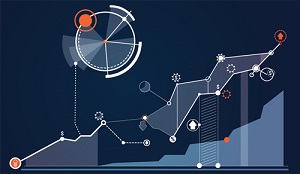The brain can be considered the human body’s “command central.” In fact, researchers estimate that the brain probably stores around 10 to 100 terabytes of data. Our brains contain roughly 100 billion neurons. Each neuron is capable of making around 1,000 connections, representing about 1,000 potential synapses. Multiply 100 billion neurons by 1,000 connections they can make, and you get 100 trillion data points (about 100 terabytes of information).
In the tech realm, graph is the brain of the enterprise. A graph database is a method of storing, accessing, and navigating large and complex interrelated sets of data. Within these datasets, we can see multiple relationships and connections between and among data. In other words, think of graph as the brain that connects a matrix of relationships in a fast, powerful, coherent way. Graph databases are a part of our everyday life. Facebook, Twitter, and LinkedIn (with its third-degree connections) all use graph databases and analytics to understand how users relate to one another and connect people with relevant contacts and content.
Graph has evolved to support digital transformation, AI, and machine learning — and it’s become a major competitive differentiator among the world’s leading companies. Organizations in virtually every industry — from financial services and healthcare to retail and manufacturing — use graph to understand their customers, reduce fraud risk, and optimize their global supply chains. Here are three examples of industry-leading companies putting graph to use — and reaping the rewards.
Jaguar Land Rover: Adding graph database and analytics to supply chain translates to 100M pounds/$136M in incremental profits per year
The automotive supply chain is one of the most complex in the world. The average car has about 4,500 parts produced by hundreds of supplies. Jaguar Land Rover, global automotive manufacturer and leading technology company, produces three-quarters of a million cars every year. JLR sought a graph solution that incorporated orders, marketing features, engineering features, parts, and suppliers.
Graph, as the “master control” brain, allows JLR to see all complex relationships between all categories – and anticipate different supply chain scenarios, manage supplier risk, and determine where potential vulnerabilities exist. This was critical after COVID, when orders and demand fluctuated. Graph also allows Jaguar Land Rover to analyze different combinations of car parts (wheel info, engine info, body info) to determine weight – and how this may affect environmental impact. Graph analytics helped JLR reduce query time across its supply chain from three weeks to just 45 minutes — boosting the company’s profit by $136M per year.
UnitedHealth Group: Finding new patient similarities for better care
UnitedHealth Group Incorporated, an American for-profit managed health care company based in Minnetonka, Minnesota, developed the largest connected graph database in healthcare. This master graph database contains 10+ billion vertices (claims, patients, doctors) and 50+ billion edges (relationships) to link, analyze, and make real-time care path recommendations for 50 million patients. The system supports 23,000+ employee users on various apps and helps drive key decisions.
UHG’s flagship use case involves the “member journey,” serving different populations of people (Rx, dental, vision, life insurance, Medicare) throughout their lifetime. The graph, which contains 1.2TB of data, houses 18 months of member information, claims, clinical data, providers, calls, house calls, and more. UHG uses its graph’s connected data to make “next best action” recommendations, using “similarity matching” to find matching patients based on 200 features across tens of millions of populations in milliseconds.
In 2020, UHG deployed graph to track COVID-related hospitalizations, discharges, test results, and more at a provider and county level. Another use case involves predicting potential patient adverse drug reactions. This capability is critical since the potential for counter-interactions increases exponentially with each new prescribed drug. Graph uses a similarity calculation to locate similar members, finding those who have been given the new drug. The provider can then see the likelihood of particular side effects and in the end, the patient gets the proper care.
Xandr/WarnerMedia: Attracting advertisers with better audience insights
Xandr, the advertising and analytics division of AT&T’s WarnerMedia, operates a digital advertising platform called Community that connects advertisers, publishers, and consumer media brands. Xandr’s Community includes more than 15 WarnerMedia properties such as Cinemax, CNN, HBO, and TNT. Each of these brands, however, has millions of consumers and associated data. Xandr aimed to develop a platform for advertisers, one capable of creating personalized commercials with different promotions being delivered to individual viewers simultaneously. Basically, Xandr needed the “brain power” of graph to navigate, connect, and simplify its multiple large and complex datasets.
Xandr built an identity graph with more than five billion vertices and seven billion edges (relationships) implemented with a ten-node distributed cluster to power the user journey for its millions of customers. An identity graph combines various identifiers into a unified view of people, the households they belong to, and devices they use. Graph enables Xandr to merge data from silos across the WarnerMedia universe to build the first and largest identity graph of its kind in the advertising industry. Thanks to data insights uncovered via graph, Xandr can identify attributes associated with people, devices, and households that allow marketers to target their audiences with customized content aligned to interests and needs. As a result, Xandr can attract companies to advertise on its platform rather than using competitive products or other outmoded approaches.
Graph highlights, discovers, and predicts complex relationships within data — connections that would otherwise be hidden. The insights gained from graph then help organizations make more informed business decisions, resulting in increased revenue, boosted business efficiency, and more. Just as the brain controls key processes within the human body, graph — as the brain of the enterprise — drives vital data-driven decisions within the organization. The brain, in both scenarios, is crucial to (human or business) survival.
About the Author

Todd Blaschka is the Chief Operating Officer at leading graph analytics platform TigerGraph and a veteran in the enterprise software industry. He is passionate about creating entirely new segments in data, analytics and AI, with the distinction of establishing graph analytics as a Gartner Top 10 Data & Analytics trend two years in a row. By fervently focusing on critical industry and customer challenges, the companies under Blaschka’s leadership have delivered significant quantifiable results to the largest brands in the world through channel and solution sales approach. Prior to TigerGraph, Blaschka led go-to-market and customer experience functions at Clustrix (acquired by MariaDB), Dataguise and IBM.
Sign up for the free insideBIGDATA newsletter.
Join us on Twitter: @InsideBigData1 – https://twitter.com/InsideBigData1





Speak Your Mind